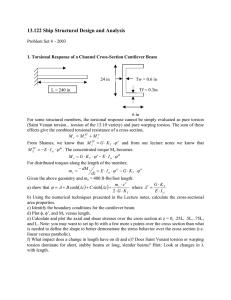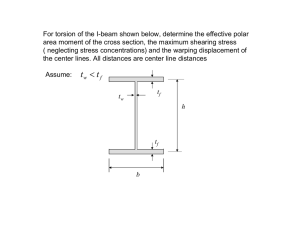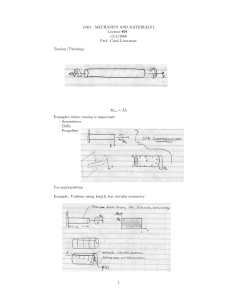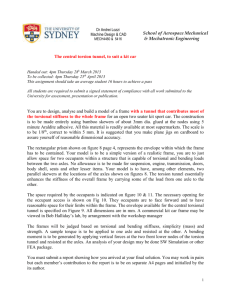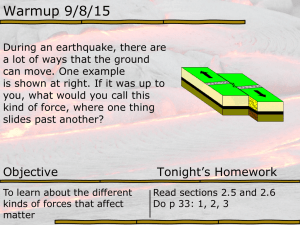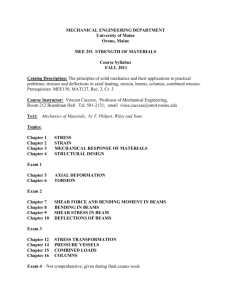Optimum Shapes and Sizes on Torsion Behaviour of I-Beam
advertisement
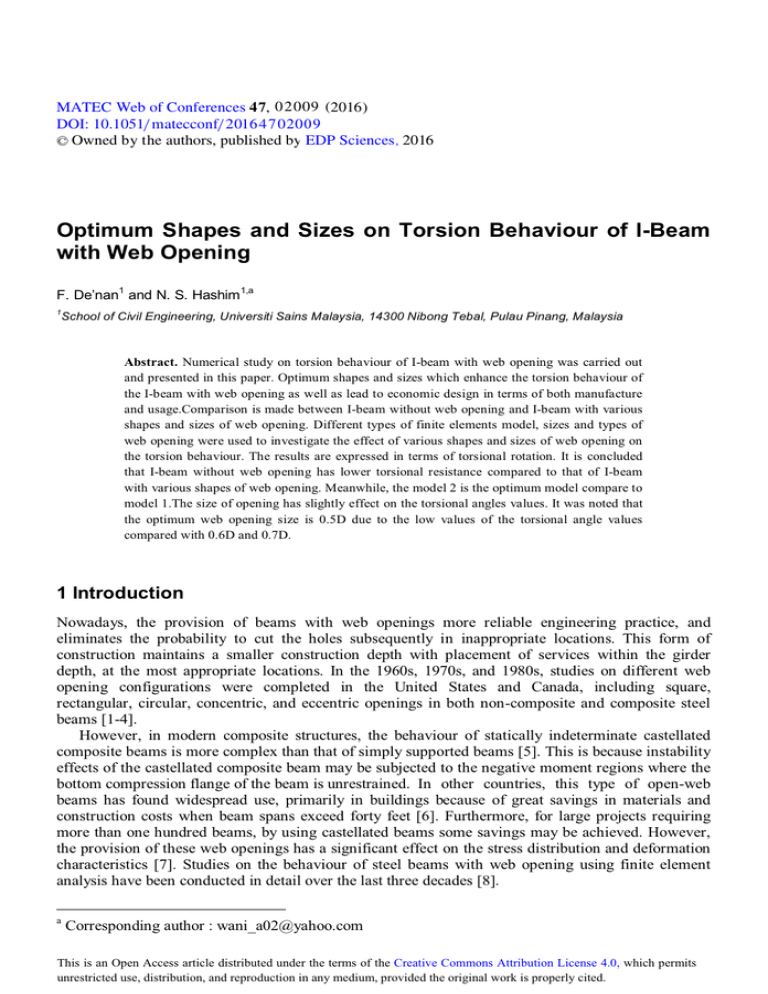
MATEC Web of Conferences 4 7, 0 2 0 0 9 (2016 ) DOI: 10.1051/ m atecconf/ 2016 47 0 2 0 09 C Owned by the authors, published by EDP Sciences, 2016 Optimum Shapes and Sizes on Torsion Behaviour of I-Beam with Web Opening F. De’nan1 and N. S. Hashim 1,a 1 School of Civil Engineering, Universiti Sains Malaysia, 14300 Nibong Tebal, Pulau Pinang, Malaysia Abstract. Numerical study on torsion behaviour of I-beam with web opening was carried out and presented in this paper. Optimum shapes and sizes which enhance the torsion behaviour of the I-beam with web opening as well as lead to economic design in terms of both manufacture and usage.Comparison is made between I-beam without web opening and I-beam with various shapes and sizes of web opening. Different types of finite elements model, sizes and types of web opening were used to investigate the effect of various shapes and sizes of web opening on the torsion behaviour. The results are expressed in terms of torsional rotation. It is concluded that I-beam without web opening has lower torsional resistance compared to that of I-beam with various shapes of web opening. Meanwhile, the model 2 is the optimum model compare to model 1.The size of opening has slightly effect on the torsional angles values. It was noted that the optimum web opening size is 0.5D due to the low values of the torsional angle values compared with 0.6D and 0.7D. 1 Introduction Nowadays, the provision of beams with web openings more reliable engineering practice, and eliminates the probability to cut the holes subsequently in inappropriate locations. This form of construction maintains a smaller construction depth with placement of services within the girder depth, at the most appropriate locations. In the 1960s, 1970s, and 1980s, studies on different web opening configurations were completed in the United States and Canada, including square, rectangular, circular, concentric, and eccentric openings in both non-composite and composite steel beams [1-4]. However, in modern composite structures, the behaviour of statically indeterminate castellated composite beams is more complex than that of simply supported beams [5]. This is because instability effects of the castellated composite beam may be subjected to the negative moment regions where the bottom compression flange of the beam is unrestrained. In other countries, this type of open-web beams has found widespread use, primarily in buildings because of great savings in materials and construction costs when beam spans exceed forty feet [6]. Furthermore, for large projects requiring more than one hundred beams, by using castellated beams some savings may be achieved. However, the provision of these web openings has a significant effect on the stress distribution and deformation characteristics [7]. Studies on the behaviour of steel beams with web opening using finite element analysis have been conducted in detail over the last three decades [8]. a Corresponding author : wani_a02@yahoo.com 4 MATEC Web of Conferences Situations arise where torsional effects are significant, typically where the demands of practical construction result in eccentrically applied loads. For instance, precast units are often supported on one side of a flange or on a shelf angle; in the temporary condition, with one side loaded, most of the load is applied eccentrically. Besides that, if for architectural reasons, a beam cannot be placed concentrically under the wall it supports [9]. Therefore, the designer has to evaluate the magnitudes of the torsional effects and consider the resistances of the members under the combined bending and torsion. In some circumstances, the designer may choose to used ‘closed’ structural hollow sections, which have a much better performance in torsion; effects and resistances for these have to be evaluated. The effect of warping in all thin-walled cross section loaded by torsion must be assumed in stress and deformation analyses of structures [10]. During the analysis, the secondary torsion moment deformation effect was included into the stiffness matrix [11]. 2 Torsion Analysis Torsion is seldom relied upon as a significant load path in the design of steel buildings. This is primarily because open shapes are torsionally very flexible and twists readily when torque is applied. In uniform torsion, the applied torque is resisted by a single set of shear stresses distributed around the cross section. The ratio of the applied torque to the twist rotation per unit length is defined as the torsional rigidity, GJ of the member, where G is the shear modulus and J is the torsional constant [12, 13]. In many cases, only uniform (or St. Venant's) torsion is applied to the ends of a member and the rate of change of angle of twist is constant along the member and the ends are free to warp. In this case the applied torque is resisted entirely by shear stresses and no warping stresses result. The total angle of twist, ϕ is given by : φ= TL GJ (1) where : T is torque applied, L is span length, J is torsional constant, and G is shear modulus. The maximum shear stress in the element of thickness, t is given by: τ t = Gtφ ' (2) However, in non-uniform torsion, the second component of the resistance to torsional loading may act when the rate of change of the angle of twist rotation varies along the member. Therefore, an additional set of shear stresses may act in conjunction with those due to uniform torsion to resist the torque acting. The stiffness of the member associated with these additional stresses is proportional to the warping rigidity, EIw, where E is the modulus of elasticity and Iw is the warping section constant [13]. When warping deformation is constrained, the member undergoes non-uniform torsion. Nonuniform torsion such as of an I-section fixed at one end is subjected to torsion at the other end. Here the member is restrained from warping freely as one end is fixed. The warping restraint causes bending deformation of the flanges in their plane in addition to twisting. The bending deformation is accompanied by a shear force in each flange. In general cases of loading and boundary condition, the warping is non-uniform along the axis of a-beam. This leads to a beam mechanical behavior that may be different from that predicted by Saint Venant beam theory or other theories which are restricted to uniform warping [14]. For thin-walled open section member, the torsion is resisted by a combination of the resistance to uniform torsion developed by shear stresses. This is almost nearly across the thickness of the section wall, and the resistance to warping torsion developed by equal and opposite flange bending and shear actions [15]. The effects of material and geometric nonlinearities on the strength s of I-section members in torsion have been clearly considered. It showed that linear first yield analyses significantly underestimate the real strengths because the favourable effects of strain-hardening, 02009-p.2 IConCEES 2015 inelastic behaviour including torque redistribution, and the longitudinal Wagner stresses that develop at large rotations have been ignored [16]. The inelastic behaviour was modelled using trilinear stressstrain curves, a combines stress yield criterion, a flow rule and a hardening rule. It was found that the present model can predict more realistic results at higher rotations than other models which ignore the tranverse uniform torsion shear stresses [17]. The method of plastic collapse analysis provides the most logical method for strength design when the strength of the cross-section member is reduced by local buckling. Such member cross-sections are usually described as ‘plastic’ or ‘compact’ and width-thickness limits for such members in bending or shear are specified in design codes [18]. Corresponding method were also developed for first hinge design (without plastic redistribution), first yield design, and local buckling design [13]. The use of plastic design should be limited to plastic members which have sufficient ductility to reach the plastic collapse mechanism. In most engineering type structures, displacement will occur due to an applied torque. The out-of – plane distortions do not induce any normal stresses providing these displacements are not restrained along the axis of the section. If the warping is restrained, warping normal stress will be induced [19]. In elastic non-uniform torsion, both the rate of change of the angle of twist dθ/dz and the longitudinal warping deflections, w vary along the length of the member. The varying warping deflections induce longitudinal strains and stresses. In this paper, torsional loading, P is applied at the end of cantilever beam. Linear analysis was carried out to obtain the torsional rotation, ϕ for both models. From the displacement value obtained from finite element analysis, the torsion rotation of each model can be calculated. Theoretically, the equation for torsion rotation is given in Equation (3). For open cross-sections, the general formula is : J= ∑ ⎛ dt 3 ⎞ ⎜ 3 ⎟ ⎝ ⎠ (3) where: b is plate lengths between points of intersection of the axes, and t is plate thickness. From Finite Element Analysis, the angle of rotation: φ fea = tan −1 dy dz (4) where: δ is displacement from the calculated node from centre rotation, and r is depth of beam (r = D/2 where D is the height of web). In design process, various strength properties of steel beam need to be taken into consideration. One of them is torsional behavior of steel beam. Therefore, it is essential to develop the knowledge about torsional behavior of the section including the torsional properties such as torsional constant (J) and warping constant (H). A general idea of torsional properties i.e. torsional constant (J) and warping constant (H) can be obtained through Appendix B BS5950: Part 1: 2000. However, the effect of torsional behavior due to openings is not stated in BS 5950. In this paper, the theoretical and finite element analysis of I-beam steel section with and without openings subject to torsion behavior was presented. The effects of various shapes and sizes of web openings and also the effect of section properties were included. Warping normal stress, displacements on longitudinal axis and angle of twist obtained through finite element analysis were used as comparison parameters between I-beam with and without web opening. 3 Numerical Analysis 3.1 Process of analysis The first part of this analysis is to find the optimum shape and size of web opening for 1.1m beam length. Then, the optimum size and shapes of web opening will be applied to different beam lengths and structural properties to study the structural behavior of a I-beam with certain web opening. Two 02009-p.3 MATEC Web of Conferences types of model, five shapes and three sizes of web opening have been used. Figure 1 shows the dimensions of a typical section of I-beam without web opening steel section. Figure 1. Shape and dimensions of a typical I-beam without web opening. 3.2 Types of model There are two types of model are used namely Model 1 and Model 2. For the Model 1, the distance between two openings is equal to 150 mm center to center and 200 mm center to center for Model 2. Meanwhile, the edge length is 50 mm for Model 1 and 100 mm for Model 2. Figure 2 shows the details summarize of the model. (a) Model 1 (b) Model 2 Figure 2. Types of model. 3.3 Sizes of opening To investigate the torsion behavior of the I-beam with web opening, there are three sizes of opening involved; the first size of opening is equal to 0.5D which the diameter of the opening is 100 mm, the second size of opening is equal to 0.6D which the diameter of the opening is 120 mm and the third size of opening is equal to 0.7D which the diameter of the opening is 140 mm where D is the height of the web. 02009-p.4 IConCEES 2015 3.4 Types of opening Five types of opening have been adopted, which are c-hexagon, octagon, hexagon, circle, square and I-beam without web opening as shown in Figure 3(a) to (f) respectively. The numerical results of Ibeam with web opening are compared with corresponding I-beam without web opening, to know better understanding of torsion behaviour of this type of beams. a) C-hexagonal opening (d) Circular opening (b) Octagonal opening (e) Square opening (c) Hexagonal opening (f) I-beam (without web opening) Figure 3. Types of opening. 4 Finite Element Analysis of I-Beam with Web Opening LUSAS 14.0 was used to discuss the pure torsion behavior of steel beam with various shapes and sizes of opening. Quadrilateral thick shell elements of quadratic interpolation order are chosen for the analysis purpose. The whole model are assigned as ungraded mild steel for its material property with Young’s Modulus, E, of 209×103 N/mm2, shear modulus, G of 79×103 N/mm2 and Poisson ratio of 0.3. These material properties remain constant throughout the analysis. All the nodes at the support are constrained the translation and rotation in x, y and z directions at one side of the beam model. The loading condition is modeled by applying one coupled point load at the edge of upper and bottom flange in opposite direction at one side of the beam model. 4.1 Convergence study A convergence study was carried out to determine suitable mesh for I-beam without web opening model. The convergence of the mesh is established by independently increasing the mesh density in each part of the model beam section. The model is given increased mesh density in all parts of the section simultaneously, and with higher-order elements (QTS8). It is observed that the increment in displacement becomes smaller from Model 1 to Model 8. The results clearly indicate that a convergence solution has been obtained when the number of elements is 2228. Elements size 20 is used in subsequent analyses. 02009-p.5 MATEC Web of Conferences convergence study was carried out to determine suitable mesh for I-beam without web opening model. The convergence of the mesh is established by independently increasing the mesh density in each part of the model beam section. The model is given increased mesh density in all parts of the section simultaneously, and with higher-order elements (QTS8). It is observed that the increment in displacement becomes smaller from Model 1 to Model 8. The results clearly indicate that a convergence solution has been obtained when the number of elements is 2228. Elements size 20 is used in subsequent analyses. 4.2 Result of numerical analysis The numerical investigations on the behaviour of I-beam with and without web opening profile section were carried out in this study. The angle of twist result of I-beam without web opening under 10kN loads is shown in Table 1 and Table 2 to Table 4 for I-beam with different types of web opening. Based on the results from Table 3, Table 4 and Table 5 it shows that the angle of twist for model 2 is lower than model 1. This is because the differences between edge and centre to centre distance of the web opening. However, the I-beam with the opening size of 0.7D has higher torsional rotation value compared to the I-beam. The size of opening has slightly effect on the torsional angles values. It was noted that the optimum web opening size is 0.5D due to the low values of the torsional angle values compared with 0.6D and 0.7D. Table 1. Torsional angle values of I-beam without web opening. Types of opening I-beam Model 1=Model 2 Angle of twist ϕ (rads) 0.05954 Table 2. Torsional angle values of I-beam with different types of 0.5D web opening sizes. Model 1 Model 2 Types of opening Angle of twist ϕ (rads) Angle of twist ϕ (rads) C-hexagon Hexagon Octagon Circular Square 0.06098 0.06122 0.06129 0.06125 0.06172 0.06061 0.06081 0.06085 0.06084 0.06123 Table 3. Torsional angle values of I-beam with different types of 0.6D web opening sizes. Types of opening C-hexagon Hexagon Octagon Circular Square Model 1 Angle of twist ϕ (rads) 0.06165 0.06197 0.06208 0.06201 0.06263 02009-p.6 Model 2 Angle of twist ϕ (rads) 0.06111 0.06136 0.06145 0.06141 0.06194 IConCEES 2015 Table 4. Torsional angle values of I-beam with different types of 0.7D web opening sizes Types of opening C-hexagon Hexagon Octagon Circular Square Model 1 Angle of twist ϕ (rads) 0.06258 0.06304 0.06326 0.06311 0.06439 Model 2 Angle of twist ϕ (rads) 0.06171 0.06208 0.06219 0.06214 0.06289 From Figure 4 it was noted that C-hexagon and hexagon shapes have a torsional angles values very close to each other. The closeness of angle of twist values could be attributed to the similarity of the form. Besides that, the differences in angle of twist values increase when the opening becomes more different in form such as circle and square. However, the values of torsional angle still close to each other as tabulated in Table 1 to Table 3. While, the model 2 is the optimum model compare to model 1. From the results, it is also clear that the different sizes of opening have close values of torsional angles to each other. In conclusion, the differences between torsional angles values of different shapes and sizes are close to each other for 1.1m length Angle of twist (rad) Angle of Twist vs Types of Opening 0.0650 0.0640 0.0630 0.0620 0.0610 0.0600 0.0590 0.0580 0.0570 Model 1 (0.5D) Model 2 (0.5D) Model 1 (0.6D) Model 2 (0.6D) Model 1 (0.7D) Model 2 (0.7D) Types of Opening Figure 4. Angle of twist, ϕ versus types of opening for I-beam with different types of web opening and without web opening. 5 Conclusions In this paper, I-beam with web opening is developed in order to compare the torsion resistance with the I-web without web opening. Three variables such as types of model, sizes and types of web opening were tested to determine their influence to the torsional rotation of the model. LUSAS software was fully used throughout this study because it provided good prediction and it is more economical for designing a structural member. From the results, it was noted that C-hexagon and hexagon shapes have a torsional angles values very close to each other. The closeness of displacement values could be attributed to the similarity of the form. Besides that, the differences in displacement values increase when the opening becomes more different in form such as circle and square. However, the values of torsional angle still close to each other. While, the model 2 is the optimum model compare to model 1. 02009-p.7 MATEC Web of Conferences Acknowledgement The authors gratefully acknowledge the financial support of Universiti Sains Malaysia (USM), during the course of this research. This research was also made possible by the Fundamental Research Grant Scheme (FRGS) (Account Number: 203/PAWAM/6071239) provided by the Ministry of Higher Education (MOHE). References [1] D. Darwin and R.C. Donahey, LFRD for composite beams with unreinforced web openings, J. of Structural Engineering, 114, 535-552, (1988). [2] D. Darwin and W.K. Lucas, LFRD for steel and composite beams with web openings, J. of Structural Engineering, 116, 1579-1593, (1990). [3] D. Darwin, Design of steel and composite beams with web openings, Steel Design Guide Series American Institute of Steel Construction 2, (1990). [4] G.D.S Verissimo, R.H. Fakury and J.C.L. Ribeiro, Design aids for unreinforced web openings in steel and composite beams with W-Shapes, Eng. J., 20, 1-14, (2011). [5] M.A. Gizejowski and W.A. Salah, Numerical modeling of composite castellated beams, International Conference on Composite Construction in Steel and Concrete 2008-Composite Construction in Steel and Concrete VI, (2011). [6] H.P.E. Estrada, J.J. Jimenez and F. Aguiniga, Cost analysis in the design of open-web castellated beams, Architectural Engineering Conference (AEI) Omaha, Nebraska, United States, (2006). [7] N.K. Chhapkhane and S.R. Kamble, Analysis of stress distribution in castellated beam using finite element method and experimental techniques, International Journal of Mechanical Engineering Applications Research, 3, 190-197, (2012). [8] T.C.H Liu and K.F. Chung, Steel beams with large web openings of various shapes and size: Finite element investigation, Journal of Constructional Steel Research, 59, 1159-1176, (2003). [9] Steel Construction Institute, Design of Steel Beams in Torsion, Berkshire, (2011). [10] J. Murin and V. Kutis, An effective finite element for torsion of constant cross-sections including warping with scondary torsion moment deformation effect, Engineering Structures, 30, 27162723, (2008). [11] J. Murin., V. Kutis, V. Kralovic and T. Sedlar, 3D Beam finite element including non uniform torsion, Procedia Engineering, 48, 436-444, (2012). [12] C.G. Salmon and J.E. Johnson, Steel Structures, Design and Behaviour, Emphasizing Load and Resistance Load Factor Design, Harper Collins College Publishers, (1996). [13] N.S. Trahair, M.A. Bradford and D.A. Nethercot, The Behaviour and Design of Steel Structures to BS 5950, Spon Press, (2001). [14] R.E. Fatmi, Non-uniform warping including the effects of torsion and shear forces, Part I: A general beam theory, International J. of Solids and Structures, 44, 5912-5929, (2007). [15] N.S. Trahair and Y.L. Pi, Torsion, bending and buckling of steel beams, Engineering Structures, 19(5), 372-377, (1997). [16] Y.L. Pi and N.S. Trahnair, Inelastic torsion of steel i-sections beams, Journal of Structural Engineering, 121(4), 609-620, (1995). [17] G. Chen and N.S. Trahair, Inelastic nonuniform torsion of steel I-Beams, J. of Constructional Steel Research, 23, 189-207, (1992). [18] N.S. Trahair and M.A. Bradford, The Behaviour and Design of Steel Structures, Chapman and Hall, London, (1991). [19] C.P. Heins, Bending and Torsional Design in Structural Members, Health and Company, Canada, (1975). 02009-p.8
